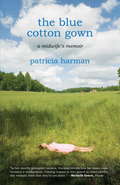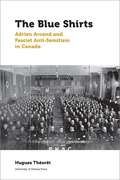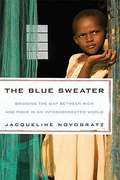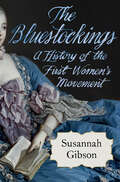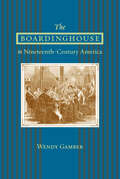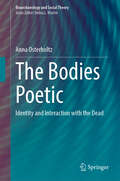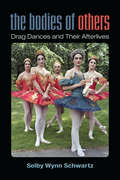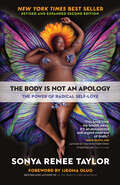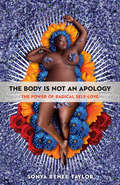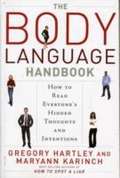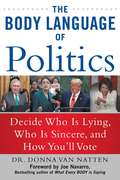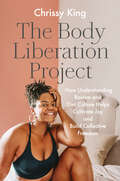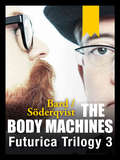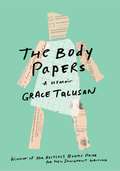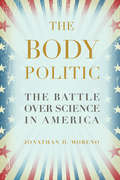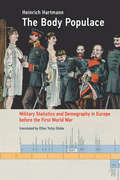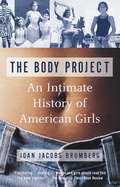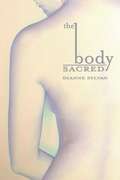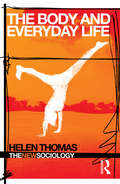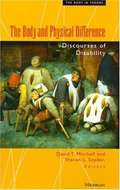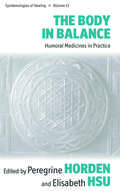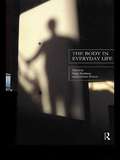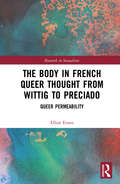- Table View
- List View
The Blue Cotton Gown
by Patricia HarmanA 2008 Indie Next PickDespite nurse-midwife Patsy Harman's own financial and personal medical trials, including her private battle with uterine cancer, she devotes herself to her patients' well-being in all aspects of their lives. They, in turn, tell her intimate stories both heartbreaking and uplifting.
The Blue Shirts: Adrien Arcand and Fascist Anti-Semitism in Canada (Canadian Studies)
by Hugues ThéorêtWhile Adolf Hitler was seizing power in Germany, Adrien Arcand was laying the foundations in Quebec for his Parti national social chrétien. The Blue Shirts, as its members were called, wore a military uniform and prominently displayed the swastika. Arcand saw Jewish conspiracy wherever he turned and his views resonated with his followers who, like him, sought a scapegoat for all the ills eroding society. Even after his imprisonment during the Second World War, the fanatical Adrien Arcand continued his correspondence with those on the frontlines of anti-semitism. Until his death in 1967, he pursued his campaign of propaganda against communists and Jews. Hugues Théorêt describes a dark period in Quebec’s ideological history using an objective approach and careful, rigorous research in this book, which won the 2015 Canada Prize (Federation for the Humanities and Social Sciences).
The Blue Sweater: Bridging the Gap between Rich and Poor in an Interconnected World
by Jacqueline NovogratzThe Blue Sweater is the inspiring story of a woman who left a career in international banking to spend her life on a quest to understand global poverty and find powerful new ways of tackling it.
The Bluestockings: A History of the First Women's Movement
by Susannah GibsonAn illuminating group portrait of the eighteenth-century women who dared to imagine an active life for themselves in both mind and spirit. In England in the 1700s, a woman who was an intellectual, spoke out, or wrote professionally was considered unnatural. After all, as the wisdom of the era dictated, a clever woman—if there were such a thing—would never make a good wife. But a circle of women called the Bluestockings did something extraordinary: coming together in glittering salons to discuss and debate as intellectual equals with men, they fought for women to be educated and to have a public role in society. In this intimate and revelatory history, Susannah Gibson delves into the lives of these pioneering women. Elizabeth Montagu established one of the most famous salons of the Bluestocking movement, with everyone from royalty to revolutionaries clamoring for an invitation to attend. Her younger sister, Sarah Scott, imagined a female-run society and created a women’s commune. Meanwhile, Hester Thrale, who also had a salon, saved her husband’s brewery from bankruptcy and, after being widowed, married a man she loved—Italian, Catholic, and not of her social class. Other women made a name for themselves through their publications, including Catharine Macaulay, author of an eight-volume history of England, and Frances Burney, author of the audacious novel Evelina. In elegant prose, Gibson reveals the close and complicated relationships between these women, how they supported and admired each other, and how they sometimes judged and exploited one another. Some rebelled quietly, while others defied propriety with adventurous and scandalous lives. With moving stories and keen insight, The Bluestockings uncovers how a group of remarkable women slowly built up an eviscerating critique of their male-dominated world that society was not yet ready to hear.
The Boardinghouse in Nineteenth-Century America
by Wendy GamberIn nineteenth-century America, the bourgeois home epitomized family, morality, and virtue. But this era also witnessed massive urban growth and the acceptance of the market as the overarching model for economic relations. A rapidly changing environment bred the antithesis of "home": the urban boardinghouse. In this groundbreaking study, Wendy Gamber explores the experiences of the numerous people—old and young, married and single, rich and poor—who made boardinghouses their homes.Gamber contends that the very existence of the boardinghouse helped create the domestic ideal of the single family home. Where the home was private, the boardinghouse theoretically was public. If homes nurtured virtue, boardinghouses supposedly bred vice. Focusing on the larger cultural meanings and the commonplace realities of women’s work, she examines how the houses were run, the landladies who operated them, and the day-to-day considerations of food, cleanliness, and petty crime. From ravenous bedbugs to penny-pinching landladies, from disreputable housemates to "boarder's beef," Gamber illuminates the annoyances—and the satisfactions—of nineteenth-century boarding life.
The Boat People: An 'Age' Investigation
by Bruce Grant"The Boat People" drew on the reports of foreign correspondents of the Australian newspaper, the "Age", which undertook this special international investigation into the events behind the refugee crisis.
The Bodies Poetic: Identity and Interaction with the Dead (Bioarchaeology and Social Theory)
by Anna OsterholtzThis book examines the intricate relationships between the living and the dead, revealing how these interactions shape group identities and facilitate ongoing negotiations of self and community. Beginning with a rich exploration of bioarchaeological theories, this volume introduces an enriched Poetics model, which deepens our understanding of not just skeletal remains, but the broader contexts that imbue bodies with social significance and how those bodies in turn can produce socially significant changes. By emphasizing the roles of performance and ritual, the work illustrates how the dead serve as powerful tools in the creation and maintenance of social structures. Through compelling case studies of ancient and modern mortuary practices, it highlights the changing meanings of the body across different historical and cultural landscapes. The volume demonstrates that while our interpretations may shift, the body remains a profound source of meaning and identity. By analyzing patterns of modification and representation, this book provides invaluable insights into social change and how group identity is forged.
The Bodies of Others: Drag Dances and Their Afterlives (Triangulations: Lesbian/Gay/Queer Theater/Drama/Performance)
by Selby Wynn SchwartzThe Bodies of Others explores the politics of gender in motion. From drag ballerinas to faux queens, and from butoh divas to the club mothers of modern dance, the book delves into four decades of drag dances on American stages. Drag dances take us beyond glittery one-liners and into the spaces between gender norms. In these backstage histories, dancers give their bodies over to other selves, opening up the category of realness. The book maps out a drag politics of embodiment, connecting drag dances to queer hope, memory, and mourning. There are aging étoiles, midnight shows, mystical séances, and all of the dust and velvet of divas in their dressing-rooms. But these forty years of drag dances are also a cultural history, including Mark Morris dancing the death of Dido in the shadow of AIDS, and the swans of Les Ballets Trockadero de Monte Carlo sketching an antiracist vision for ballet. Drawing on queer theory, dance history, and the embodied practices of dancers themselves, The Bodies of Others examines the ways in which drag dances undertake the work of a shared queer and trans politics.
The Body Is Not an Apology, Second Edition: The Power of Radical Self-Love
by Sonya Renee TaylorNew York Times bestseller! "To build a world that works for everyone, we must first make the radical decision to love every facet of ourselves. . . . 'The body is not an apology' is the mantra we should all embrace."—Kimberlé Crenshaw, legal scholar and founder and Executive Director, African American Policy ForumHumans are a varied and divergent bunch with all manner of beliefs, morals, and bodies. Systems of oppression thrive off our inability to make peace with difference and injure the relationship we have with our own bodies.The Body Is Not an Apology offers radical self-love as the balm to heal the wounds inflicted by these violent systems. World-renowned activist and poet Sonya Renee Taylor invites us to reconnect with the radical origins of our minds and bodies and celebrate our collective, enduring strength. As we awaken to our own indoctrinated body shame, we feel inspired to awaken others and to interrupt the systems that perpetuate body shame and oppression against all bodies. When we act from this truth on a global scale, we usher in the transformative opportunity of radical self-love, which is the opportunity for a more just, equitable, and compassionate world—for us all.This second edition includes stories from Taylor's travels around the world combating body terrorism and shines a light on the path toward liberation guided by love. In a brand new final chapter, she offers specific tools, actions, and resources for confronting racism, sexism, ableism, homophobia, and transphobia. And she provides a case study showing how radical self-love not only dismantles shame and self-loathing in us but has the power to dismantle entire systems of injustice. Together with the accompanying workbook, Your Body Is Not an Apology, Taylor brings the practice of radical self-love to life.
The Body Is Not an Apology: The Power of Radical Self-Love
by Sonya Renee TaylorThe Body Is Not an ApologyThe Power of Radical Self-LoveAgainst a global backdrop of war, social upheaval, and personal despair, there is a growing sense of urgency to challenge the systems of oppression that dehumanize bodies and strip us of our shared humanity. Rather than feel helpless in the face of oppression, world-renowned activist, performance poet, and author Sonya Renee Taylor teaches us how to turn to the power of radical self-love in her new book, The Body Is Not an Apology. Radical self-love is the guiding framework that transforms the learned self-hatred of our bodies and the prejudices we have about other people's bodies into a vision of compassion, equity, and justice. In a revolutionary departure from the corporate self-help and body-positivity movement, Taylor forges the inextricable bond between radical self-love and social justice. The first step is recognizing that we have all been indoctrinated into a system of body shame that profits off of our self-hatred. When we ask ourselves, “Who benefits from our collective shame?” we can begin to make the distinction between the messages we are receiving about our bodies or other bodies and the truth. This book moves us beyond our all-too-often hidden lives, where we are easily encouraged to forget that we are whole humans having whole human experiences in our bodies alongside others. Radical self-love encourages us to embark on a personal journey of transformation with thoughtful reflection on the origins of our minds and bodies as a source of strength. In doing this, we not only learn to reject negative messages about ourselves but begin to thwart the very power structures that uphold them. Systems of oppression thrive off of our inability to make peace with bodies and difference. Radical self-love not only dismantles shame and self-loathing in us but has the power to dismantle global systems of injustice—because when we make peace with our bodies, only then do we have the capacity to truly make peace with the bodies of others.
The Body Language Handbook: How to Read Everyone's Hidden Thoughts and Intentions
by Gregory Hartley Maryann KarinchIn "The Body Language Handbook", the authors use candid photos of real people in stress-free situations, then juxtapose them against others showing the same people responding to different kinds of stimulus to illustrate the power of body language. By going step-by-step from the holistic to the detailed, you'll quickly discover when body language indicates something significant, and when an itch is just an itch.
The Body Language of Politics: Decide Who is Lying, Who is Sincere, and How You'll Vote
by Dr. Donna Van NattenLearn how to spot the lies and deceptions of our politicians in action. You can&’t turn on the television, check your phone, or scroll through social media without being besieged with political headlines and the "Who&’s Who" of today&’s news. With so much spoon-fed to us by the media, fake news, and from politicians themselves, it&’s time to take the reins and control what you see, feel, and know so you can make informed political choices in our hot, political environment. In The Body Language of Politics, body language expert Dr. Donna Van Natten provides you with the tools and resources that you need to analyze movements of today's most notable politicians. She looks at some of the looming figures in our political landscape—Donald Trump, Hillary Clinton, Nancy Pelosi, Mitch McConnell, Chuck Schumer, and Alexandria Ocasio-Cortez, among others—and analyzes their physical behaviors, breaking down the lies and deceptions embedded in their everyday movements. Further, Dr. Van Natten challenges you to understand your own emotional biases towards certain politicians, and examine how that may skew your read of their body language. Finally, she confronts the gendered stereotypes that we often apply to our nation's leaders, examining how those labels play into our opinions of politicians. Clear, concise, and filled with expert knowledge, The Body Language of Politics will help you make an informed decision at the voting booth.
The Body Liberation Project: How Understanding Racism and Diet Culture Helps Cultivate Joy and Build Collective Freedom
by Chrissy KingFrom author and wellness personality Chrissy King, an exciting, genre-redefining narrative mix of memoir, inspiration, and activities and prompts, with timely messages about social and racial justice and how the world needs to move beyond body positivity to something even more exciting and revolutionary: body liberation.When Chrissy King first joined a gym, she had one goal in mind: to &“get skinny.&” In pursuit of this goal, she fell into the all-too-common cycle of &“not enough-ness&”; no matter what she achieved, there was always something she felt she needed to change about her body, her appearance, herself. This made her realize the most liberating truth of all: She was not the problem. Diet and fitness industries rooted in white supremacy were the problem; Eurocentric and carefully manufactured beauty standards were the problem; discourses telling her that her happiness was directly tied to her physical appearance were the problem. So she created an actionable method to redefine the relationship we have with our bodies, thereby achieving a sense of self-worth that is completely separate from how we look.The Body Liberation Project is about finding actual freedom in our bodies by discovering strength and aspects of fitness, movement, and eating that work for YOU. It&’s about realizing that the goal is not to look at our bodies and love everything we see; it&’s to understand that at our essence we are so much more than our bodies. But it&’s also about recognizing the harsh realities that prohibit people in marginalized bodies from being able to do so. Society constantly bombards those who fall outside Eurocentric standards of beauty (think Black, fat, trans, etc.) with the message that they are less attractive, and part of the journey toward body liberation is examining your own privilege, acknowledging the harm you may be causing others, and mourning your old ideas about what a body &“should&” look like. Recognizing that none of us are free until all of us are, Chrissy King shares the wisdom, the tools, and the inspiration to motivate readers to find body liberation and, even more important, to pass it on.
The Body Machines
by Alexander Bard Jan SöderqvistThe final episode of The Futurica Trilogy. It departs from repeated questions about the Death of the Individual in the Age of Interactivity. The authors rehabilitate Descartes old concept of the body machine and transform it into the foundation of a very anti-cartesian, materialist image of humanity, relevant for the new, emerging paradigm--we're entering The Age of The Body Machines.
The Body Papers
by Grace TalusanBorn in the Philippines, young Grace Talusan moves with her family to a New England suburb in the 1970s. At school, she confronts racism as one of the few kids with a brown face. At home, the confusion is worse: her grandfather’s nightly visits to her room leave her hurt and terrified, and she learns to build a protective wall of silence that maps onto the larger silence practiced by her Catholic Filipino family. Talusan learns as a teenager that her family’s legal status in the country has always hung by a thread—for a time, they were “illegal.” Family, she’s told, must be put first. <p><p> The abuse and trauma Talusan suffers as a child affects all her relationships, her mental health, and her relationship with her own body. Later, she learns that her family history is threaded with violence and abuse. And she discovers another devastating family thread: cancer. In her thirties, Talusan must decide whether to undergo preventive surgeries to remove her breasts and ovaries. Despite all this, she finds love, and success as a teacher. On a fellowship, Talusan and her husband return to the Philippines, where she revisits her family’s ancestral home and tries to reclaim a lost piece of herself. <p> Not every family legacy is destructive. From her parents, Talusan has learned to tell stories in order to continue. The generosity of spirit and literary acuity of this debut memoir are a testament to her determination and resilience. In excavating such abuse and trauma, and supplementing her story with government documents, medical records, and family photos, Talusan gives voice to unspeakable experience, and shines a light of hope into the darkness.
The Body Politic
by Jonathan D. MorenoA Kirkus Reviews Best Book of the Year and Scientific American Book Club selection"Moreno pulls apart the debates on eugenics, abortion, end-of-life decisions, embryonic stem-cell research, reproductive cloning, chimeras and synthetic biology, among others, carefully reassembling what's at stake for each side. In graceful, sparkling prose, he illuminates intricate threads of history and complex philosophical arguments. . . . Highly recommended for anyone interested in the[se] vital issues." -Kirkus Reviews (starred review)We have entered what is called the "biological century" and a new biopolitics has emerged to address the implications for America's collective value system, our well-being, and ultimately, our future. The Body Politic is the first book to recognize and assess this new force in our political landscape-one that fuels today's culture wars and has motivated politicians of all stripes to reexamine their platforms. As Moreno explains the most contentious issues, he also offers an engaging history of the intersection between science and democracy in American life, a reasoned (and often surprising) analysis of how different political ideologies view scientific controversies, and a vision for how the new biopolitics can help shape the quality of our lives.Jonathan D. Moreno is the David and Lyn Silfen University Professor at the University of Pennsylvania and the editor-in-chief for the Center for American Progress' online magazine, Science Progress. He divides his time between Philadelphia and Washington, DC.
The Body Populace: Military Statistics and Demography in Europe before the First World War (Transformations: Studies in the History of Science and Technology)
by Heinrich HartmannHow data gathered from national conscriptions in pre–World War I Europe influenced understandings of population fitness and redefined society as a collective body. In pre–World War I Europe, individual fitness was increasingly related to building and preserving collective society. Army recruitment offered the most important opportunity to screen male citizens' fitness, raising questions of how to define fitness for soldiers and how to translate this criteria outside the military context. In this book, Heinrich Hartmann explores the historical circumstances that shaped collective understandings of fitness in Europe before World War I and how these were intertwined with a fear of demographic decline and degeneration. This dynamic gained momentum through the circulation of knowledge among European nations, but also through the scenarios of military confrontations. Hartmann provides a science history of military statistics in Germany, France, and Switzerland in the decades preceding World War I, considering how information gathered during national conscriptions generated data about the health and fitness of the population. Defined by masculine concepts, conscription examinations went far beyond the individuals they tested and measured. Scholars of the time aspired to pin down the “nation” in concrete numerical terms, drawing on data from examinations to redefine society as a “collective body” that could be counted, measured, and examined. The Body Populace explores the historical specificity and contingency of data-gathering techniques, recounts their uses and abuses, and provides a timely contribution to the growing historiography of Big Data. It sheds light on a crucial moment in nineteenth and early twentieth century European history—when statistical data and demographical knowledge shaped new notions of masculinity, fostered fears of degeneration, and gave rise to eugenic thinking.
The Body Project: An Intimate History of American Girls
by Joan Jacobs Brumberg"Timely and sympathetic . . . a work of impassioned advocacy. " --People. A hundred years ago, women were lacing themselves into corsets and teaching their daughters to do the same. The ideal of the day, however, was inner beauty: a focus on good deeds and a pure heart. Today American women have more social choices and personal freedom than ever before. But fifty-three percent of our girls are dissatisfied with their bodies by the age of thirteen, and many begin a pattern of weight obsession and dieting as early as eight or nine. Why? In The Body Project, historian Joan Jacobs Brumberg answers this question, drawing on diary excerpts and media images from 1830 to the present. Tracing girls' attitudes toward topics ranging from breast size and menstruation to hair, clothing, and cosmetics, she exposes the shift from the Victorian concern with inner beauty to our modern focus on outward appearance--in particular, the desire to be model-thin and sexy. Compassionate, insightful, and gracefully written,The Body Project explores the gains and losses adolescent girls have inherited since they shed the corset and the ideal of virginity for a new world of sexual freedom and consumerism--a world in which the body is their primary project. "Joan Brumberg's book offers us an insightful and entertaining history behind the destructive mantra of the '90s--'I hate my body!'" --Katie Couric
The Body Sacred
by Dianne SylvanEach chapter of The Body Sacred includes spells, rituals, myths, and meditations designed to help you build a positive self-image and rejoice in the sacred aspects of the female body you were blessed with. Explore six divine female archetypes, and discover how these powerful themes can help you love and celebrate your body as a gorgeous, living temple of the Goddess.
The Body and Everyday Life (The New Sociology)
by Helen ThomasIn recent years, there has been an explosion of interest in the contemporary social study of the body which has raised important theoretical and methodological questions regarding traditional social and cultural analysis. It has also generated corporeal theories that highlight the fluid, shifting, yet situated character of the body in society. In turn, these corporeal theories have implications for social relations in an era of new technologies and global market economies. The Body and Everyday Life offers a lively and comprehensive introduction to the study of the body. It uses case studies in performance practices to examine the key concepts, methods and critical insights gained from this area. It includes sections on: ethnographies of the body bodies of performance performing gender the ageing performing body. This book clearly illustrates the complex relationships that exist between the body, society and everyday life, and considers the negative and positive implications for the development of future socio-cultural analysis in the field. It will be an invaluable introduction for students of sociology, body studies, gender studies, dance and performance, and cultural studies.
The Body and Physical Difference: Discourses of Disability
by David T. Mitchell Sharon L. SnyderFor years the subject of human disability has engaged those in the biological, social and cognitive sciences, while at the same time, it has been curiously neglected within the humanities.The Body and Physical Difference seeks to introduce the field of disability studies into the humanities by exploring the fantasies and fictions that have crystallized around conceptions of physical and cognitive difference. Based on the premise that the significance of disabilities in culture and the arts has been culturally vexed as well as historically erased, the collection probes our society's pathological investment in human variability and "aberrancy." The contributors demonstrate how definitions of disability underpin fundamental concepts such as normalcy, health, bodily integrity, individuality, citizenship, and morality--all terms that define the very essence of what it means to be human. The book provides a provocative range of topics and perspectives: the absence of physical "otherness" in Ancient Greece, the depiction of the female invalid in Victorian literature, the production of tragic innocence in British and American telethons, the reconstruction of Civil War amputees, and disability as the aesthetic basis for definitions of expendable life within the modern eugenics movement. With this new, secure anchoring in the humanities, disability studies now emerges as a significant strain in contemporary theories of identity and social marginality. Moving beyond the oversimplification that disabled people are marginalized and made invisible by able-ist assumptions and practices, the contributors demonstrate that representation is founded upon the perpetual exhibition of human anomalies. In this sense, all art can be said to migrate toward the "freakish" and the "grotesque." Such a project paradoxically makes disability the exception and the rule of the desire to represent that which has been traditionally out-of-bounds in polite discourse. The Body and Physical Difference has relevance across a wide range of academic specialties such as cultural studies, the sociology of medicine, history, literature and medicine, the allied health professions, rehabilitation, aesthetics, philosophical discourses of the body, literary and film studies, and narrative theory. David T. Mitchell is Assistant Professor of English, Northern Michigan University. Sharon L. Snyder teaches film and literature at Northern Michigan University.
The Body and the City: Psychoanalysis, Space and Subjectivity
by Steve PileOver the last century, psychoanalysis has transformed the ways in which we think about our relationships with others. Psychoanalytic concepts and methods, such as the unconscious and dream analysis, have greatly impacted on social, cultural and political theory. Reinterpreting the ways in which Geography has explored people's mental maps and their deepest feelings about places, The Body and the City outlines a new cartography of the subject. The author maps key coordinates of meaning, identity and power across the sites of body and city. Exploring a wide range of critical thinking, particularly the work of Lefebvre, Freud and Lacan, he analyses the dialectic between the individual and the external world to present a pathbreaking psychoanalysis of space.
The Body in Balance
by Elisabeth Hsu Peregrine HordenFocusing on practice more than theory, this collection offers new perspectives for studying the so-called "humoral medical traditions," as they have flourished around the globe during the last 2,000 years. Exploring notions of "balance" in medical cultures across Eurasia, Africa and the Americas, from antiquity to the present, the volume revisits "harmony" and "holism" as main characteristics of those traditions. It foregrounds a dynamic notion of balance and asks how balance is defined or conceptualized, by whom, for whom and in what circumstances. Balance need not connoteegalitarianism or equilibrium. Rather, it alludes to morals of self care exercised in place of excessiveness and indulgences after long periods of a life in dearth. As the moral becomes visceral, the question arises: what constitutes the visceral in a body that is in constant flux and flow? How far, and in what ways, are there fundamental properties or constituents in those bodies?
The Body in Everyday Life (The New Sociology)
by Sarah Nettleton Jonathan WatsonWe all have a body, but how does it impact upon our day to day life? This book sets out to explore how ordinary women, men and children talk about their bodies, through four central themes:-* physical and emotional bodies* illness and disability* gender* ageing.A coherent collection of such empirical research, The Body in Everyday Life provides an accessible introduction to the sociology of the body, a field previously dominated by theoretical or philosophical accounts.
The Body in French Queer Thought from Wittig to Preciado: Queer Permeability (Research in Sexualities)
by Elliot EvansThe Body in French Queer Thought from Wittig to Preciado: Queer Permeability identifies a common concern in French queer works for the materiality of the body, arguing for a return to the body as fundamental to queer thought and politics, from HIV onwards. The emergence of queer theory in France offers an opportunity to re-evaluate the state of queer thought more widely: what matters to queer theory today? The energy of queer thinking in France – grounded in activist groups and galvanised by recent hostility towards same-sex marriage and gay parenting – has reignited queer debates. Examining Paul B. Preciado’s experimentation with theory and pharmaceutical testosterone; Monique Wittig’s exploration of the body through radically innovative language; and, finally, the surgical performances of French artist ORLAN’s ‘Art Charnel’, this book asks how we are able to account for the material body in philosophy, literature, and visual image. This is an important work for academics and students in French studies, in Anglophone queer studies, gender and sexuality studies and transgender studies, and will have significant interest for specialists of cultural translation and visual art and culture.
